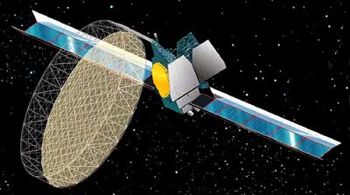According to Gunter's Space Page discussion of early versions of the Hughes HS-702 Bus:
The first version of the 702 used solar arrays with concentrators. These concentrators tended to early fogging, as due to an inherent design flaw the outgassing of the solar cells was higher than expected. This fogging lead to much reduced lifetime. The flaw was corrected in later versions with higher power triple-junction gallium arsenide solar cells.
Perhaps if it was the only issue the fogging of the reflectors due to outgassing could have been managed, but I can imagine other problems as well:
- Additional complexity of unfolding and precise alignment and flatness adds risk (see US7321095)
- Deviations in flatness and inclination angle of reflectors can lead to non-uniform illumination of the cells. Unequal illumination of cells can lead to loss of efficiency or other problems.
- Narrower window of attitudes, the reflectors are designed for a certain attitude, any change can lead to steeper drop-off and loss of power, compared to a flat panels approximately $cos(\theta)$ behavior.
Question: I'm wondering if the concentrator reflectors were always intended as a stop-gap measure to deliver a higher level of power in anticipation of improved triple-junction cells, or was the original plan to use the regularly to always achieve maximal power? Has this array-scale concentrator technique every been used again, as opposed to individual per-cell concentrators?
From Gunter's Space Page article for HS-702:
Following failures of 702 models have occurred:
- Anik F1: - degradation of solar concentrators - long term power loss
- Galaxy 11: - degradation of solar concentrators - long term power loss
- PAS 1R: - degradation of solar concentrators - long term power loss
- Thuraya 1: - degradation of solar concentrators - long term power loss
- XM 1: - degradation of solar concentrators - long term power loss
- XM 2: - degradation of solar concentrators - long term power loss
above: Drawing of APMT 1, and Thuraya-1. credit: Hughes, from Astronautix.
above: Video telemetry (first ever!) of a solar panel unfolding, Galaxy-11. credit: Hughes, from Spaceflight Now.
From the 24-Feb-2000 Spaceflight Now article Camera sees giant Hughes satellite deploying its wings:
The HS 702 solar wings carry angled solar reflector panels along each side that concentrate more of the sun's rays onto the solar cells in order to generate increased power. The gallium arsenide solar cells are among the most efficient available, able to convert nearly 25 percent of the sun's rays into spacecraft power. The satellite, Galaxy 11, was built by HSC for PanAmSat Corporation and was launched on an Ariane rocket on Dec. 21, 1999.
below: Artist's conception of a Hughes HS-702 bus, credit: Hughes, from What When How.




